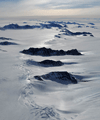March
Scientists plumb the secret depths of Antarctica

A large scale project to map Antarctica has discovered the continent contains more ice than previously understood.
Sixty scientists from 14 institutions in 35 countries, including Dr Neil Ross from Newcastle University, have been involved in the BEDMAP2 project, co-ordinated by the British Antarctic Survey.
Usind data collected from radio echo sounding measurements, seismic techniques, satellite readings and cartographic data, they have created the most detailed map of what lies beneath Antarctica's ice sheets.
It has revealed a landscape of mountain ranges and plains cut by gorges and valleys much deeper than previously thought. Several features of the bed have been revealed for the first time including a new deepest point at the Byrd Glacier in Victoria Land which is 2,870 metres below sea level, making it the lowest point on any of the Earth’s continental plates.
The study has found:
• The volume of ice in Antarctica is 4.6 per cent greater than previously thought
• The mean bed depth of Antarctica, at 95 metres, is 60m lower than estimated
• The volume of ice that is grounded with a bed below sea level is 23 per cent greater than originally thought meaning there is a larger volume of ice that is susceptible to rapid melting. The ice that rests just below sea level is vulnerable to warming from ocean currents
• The total potential contribution to global sea level rise from Antarctica is 58 metres, similar to previous estimates but a much more accurate measurement
• The new deepest point, under Byrd Glacier, around 400 metres deeper than the previously identified deepest point
Dr Neil Ross, a lecturer in physical geography, surveyed 25,000 kilometres of the continent’s Institute and Möller ice streams. He said: “ As well as being beautiful and intrinsically fascinating, BEDMAP2 is a vital resource for predicting how the Antarctic ice sheet may contribute to future sea level rise, and for reconstructing how the ice sheet has changed through geological time. I am delighted to have played a part in the development of this highly important map.”
Press release adapted from the British Antarctic Survey
published on: 8 March 2013
